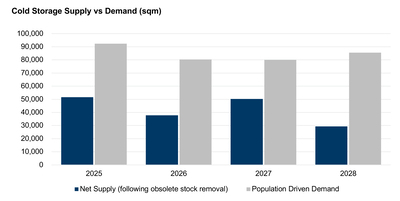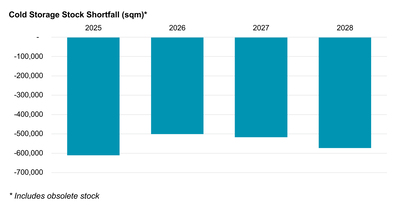Frozen Logistics: new report reveals cold storage is in short supply
Wednesday, 16 July, 2025

As Australia’s population grows and demand surges across the food logistics and pharmaceutical sectors, new modelling from Cushman & Wakefield shows the country’s Cold Storage market is struggling to keep up. Current storage vacancy sits at 0.6%, well below the broader logistics and industrial average of 3.0%. With just 3.1million m2 of existing stock and an undersupply of around 130,000 m2, the sector is under increasing pressure, especially as an estimated 15% of existing facilities are no longer fit for purpose.
The Frozen Logistics report provides one of the first national assessments of cold storage vacancy in Australia, combining a detailed stock map with direct insights from major occupiers about their infrastructure needs. With the population expected to grow by approximately 3.8 million people over the next decade, an additional 950,000 m2 of cold storage space will be needed to meet demand, well below the current pipeline of supply. Further compounding the undersupply, the research found advancing tenant requirements could render up to 25% of cold storage space obsolete by the early 2030s.
Luke Crawford, Head of Logistics and Industrial Research, Australia at Cushman & Wakefield, said the strength of demand has shifted development patterns across the market, especially with speculative builds starting to emerge, which was a rarity in the cold storage sector before 2020.
“Cold storage has undergone significant growth over the past decade. Online food delivery, pharmaceuticals and industry consolidation are driving demand, and it’s reshaping how the sector looks at development. We’re seeing speculative projects receive strong interest from occupiers, particularly for freezer space as there is next to no vacancy for this type of product nationally,” he said.
“Traditionally, cold storage has been a contract-led sector, with occupiers locking in long-term deals before facilities are even built. But due to demand, developers like Hale and Aliro, are more confident building without a tenant in place and it’s paying off.”
Solving the undersupply challenge
Obsolescence is a growing concern across the industrial sector, but it’s even more pronounced in cold storage. As tenant needs shift toward greater automation, sustainability and operational flexibility, older facilities are aging out faster. Location, however, continues to be the most important factor, according to occupiers.
David Hall, National Director, Head of Brokerage ANZ at Cushman & Wakefield, said retrofitting existing sites, particularly those in central locations, offers a critical pathway to easing the shortage.
“We know approvals and lead times for new, build-to-suit facilities are too long for many occupiers. That’s where retrofitting existing ambient warehouse stock to cold storage can provide a solution to better meet occupier needs,” he said.
“It’s not straightforward given the structural, mechanical and operational considerations, but for well-located sites, the potential upside is significant. We’re already seeing a few early movers test this approach, and we expect it to pick up pace over the next five years. Every retrofit is different and there is no one-size-fits-all solution, but in the right context it can help owners and occupiers unlock value and a faster path to market.”
Norco celebrates two years of ice cream making at its reopened factory
Norco has celebrated two years since its Lismore ice cream factory reopened, following the 2022...
$300m production facility for frozen chips being built in Vic
An international food manufacturer plans to establish its first Australian 24 h production...
Fonterra invests NZ$75m for new butter line at Clandeboye
Part of Fonterra's NZ$1bn investment plan, this project will help increase production...













